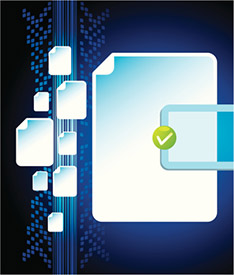Simplify E-Discovery with Predictive Coding
 Complying with an e-discovery request can be a major undertaking for an organization’s IT and legal staff, mainly because finding and reviewing relevant documents is so time-consuming. For e-discovery, you may need to locate and go through emails, voicemail messages, application data, documentation, contracts, social media, and many more types of data.
Complying with an e-discovery request can be a major undertaking for an organization’s IT and legal staff, mainly because finding and reviewing relevant documents is so time-consuming. For e-discovery, you may need to locate and go through emails, voicemail messages, application data, documentation, contracts, social media, and many more types of data.
The time spent finding and reviewing all those documents costs your organization money — both in legal billings and in the use of employee resources. Fortunately, new methods of technology-assisted review are emerging that can help make the human review process easier and faster, thus simplifying e-discovery.
What is predictive coding?
One technology that holds promise for significantly cutting the amount of time required for e-discovery is predictive coding. In predictive coding, a person familiar with the contents of a representative subset of the documents (such as an attorney) enters information that identifies and categorizes them (e.g., by relevance).
The predictive coding engine — which is part of an e-discovery application — creates rules based on this information and applies them to the complete set of documents included in the e-discovery process. The end goal is to greatly reduce the number of documents that must be manually reviewed, thereby drastically reducing the time required for e-discovery.
Dan Pelletier, Director of eDiscovery and Information Governance Consulting at US East, explains predictive coding further: “New technology has emerged using semantic analysis and other technologies that allow you to start with a sample of the total set of documents. The software creates a profile of what is and isn’t relevant from the sample of documents, and then goes out to the remainder of the documents and codes them appropriately based on the sample.”
The key to predictive coding’s effectiveness is the accuracy of the human input, so having experienced lawyers do the initial coding on the sample document set is crucial, says Pelletier. “When you have a million documents to review, often the document review is farmed out to contract attorneys who don’t have a real, clear understanding of the case. In the case of predictive coding, the people that do the coding are people really close to the issues of the case. So when they code the sample, it’s actually more accurate than what you’d get farming this out.”
Predictive coding for information governance
Predictive coding isn’t just for e-discovery. It can be used to help the organization more efficiently categorize and store data, as part of an information governance strategy.
“People are actually starting to use predictive coding technologies as part of their information governance programs,” says Pelletier. “So for instance, if your governance program defines that anything that has to do with taxation needs to be kept for seven years, you can use this same technology not to compare the documents for litigation but to determine if the documents are related to taxation. Then you can use it to tag and identify documents that are candidates for retention or deletion,” he says.
The further technology advances, the more data technology users can create. Fortunately, technology is also enabling new methods such as predictive coding that make the ever-expanding mass of data easier to manage.
[cta]Want to learn more about how predictive coding can help your e-discovery efforts? Contact US East at info@useastusa.com or by phone at 212-840-3444. Or visit our website.[/cta]
